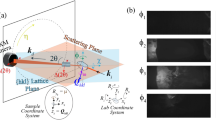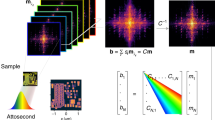Abstract
We demonstrate here the imaging of light atoms by hard X-ray holography. Using intense synchrotron radiation for the excitation, the oxygen and nickel atoms in a nickel oxide sample are imaged in three dimensions with high resolution inside a volume of about 1,000 cubic ångströms. These remarkable characteristics mean that X-ray holography bridges the gap between diffraction, which relies on long-range order, and extended X-ray absorption fine structure, which gives information on the local environment of atoms.
Similar content being viewed by others
Main
For atomic resolution in solids by hard X-ray holography, selected atoms in the sample serve as reference points and their local environments are holographically imaged1,2,3. After holographic reconstruction, the intensity of the atoms is proportional to the square of their atomic number (z) and also to r−2, where r is the distance from the central atom. To see an atom with a low value of z or at a large distance from the reference, the holographic oscillations therefore have to be measured with great precision.
To achieve this precision, we have used synchrotron radiation and a sophisticated experimental set-up4,5, carrying out our measurements at the two undulator beamlines ID 32 and ID 22 of the European Synchrotron Radiation Facility. To avoid the twin images inherent in the traditional holographic type of reconstruction, which can distort the three-dimensional real-space image6, we collected holograms at eight different energies (from 16.4 to 19.9 keV, in 0.5-keV steps)3,7.
For data handling4, we incorporated background subtraction, deconvolution of the contribution of the complementary hologram, extension of the hologram to the full sphere by using the measured symmetries5, low-pass filtering8 and, finally, multiple energy reconstruction by the Helmholtz–Kirchhoff transformation modified according to Barton7.
The results of the measurements and analysis are shown in Fig. 1. The hologram measured at 17.9 keV incident energy is depicted after background subtraction (Fig. 1, top left): the different symmetry points of the hologram and the standing-wave line pattern (the narrow dark and bright lines) can be readily identified. We used these to extend the hologram5 to those areas that could not be measured (shaded in grey) (another seven holograms have similar features and comparable quality).
Top left, the hologram of NiO is shown in three dimensions on a spherical surface that extends to the half sphere. Shaded grey area indicates the part of the full holographic information that could not be measured. Bottom left, three-dimensional real-space image of atoms within a sphere of radius 6 Å. Oxygen atoms are blue and nickel atoms are red. Bottom right, (100) atomic plane. Atoms can be reconstructed over large distances with isotropic resolution. Top right, for clarity it is also shown how the reconstructed plane relates to the lattice and to the central atom. The colour scale is proportional to the holographic reconstructed intensity.
In the final three-dimensional real-space image, the oxygen atoms are evident (Fig. 1, bottom left) (only a limited part of the reconstruction is shown for clarity). The precise measurement of these holograms allowed us not only to reconstruct the oxygen atoms, but also to image the much more distant nickel atoms up to the seventh coordination shell. This means that there are about 150 atoms in the volume imaged holographically. The (100) atomic plane is shown with distant atoms in Fig. 1, bottom right, illustrating the high and isotropic resolution of the measurement.
Holograpic imaging might be extended to systems in which long-range translation periodicity is not present and where X-ray diffraction or extended X-ray absorption fine structure cannot be used efficiently, such as for quasicrystals or single molecules. In quasicrystals, we could see atomic decorations directly. A combination of fourth-generation free-electron laser-type X-ray sources with holographic imaging and reconstruction should lead to the structural determination of single molecules, viruses and other minute systems that cannot be crystallized.
References
Szöke, A. in Short Wavelength Coherent Radiation: Generation and Applications (eds Attwood, D. T. & Boker, J.) 361–367 (AIP Conf. Proc. no. 147, American Institute of Physics, New York, 1986 ).
Tegze, M. & Faigel, G. Nature 380, 49–51 (1996).
Gog, T. et al. Phys. Rev. Lett. 76, 3132– 3135 (1996).
Faigel, G. & Tegze, M. Rep. Progr. Phys. 62, 355–392 (1999).
Tegze, M., Faigel, G., Marchesini, S., Belakhovsky, M. & Chumakov, A. I. Phys. Rev. Lett. 82, 4847–4851 (1999).
Len, P. M., Thevuthasan, S., Fadley, C. S., Kaduwela, A. P. & Van Hove, M. A. Phys. Rev. B 50, 11275–11278 ( 1994).
Barton, J. J. Phys. Rev. Lett. 67, 3106–3109 (1991).
Tegze, M. & Faigel, G. Europhys. Lett. 16, 41–46 (1991).
Author information
Authors and Affiliations
Rights and permissions
About this article
Cite this article
Tegze, M., Faigel, G., Marchesini, S. et al. Imaging light atoms by X-ray holography . Nature 407, 38 (2000). https://doi.org/10.1038/35024153
Issue Date:
DOI: https://doi.org/10.1038/35024153
Comments
By submitting a comment you agree to abide by our Terms and Community Guidelines. If you find something abusive or that does not comply with our terms or guidelines please flag it as inappropriate.




